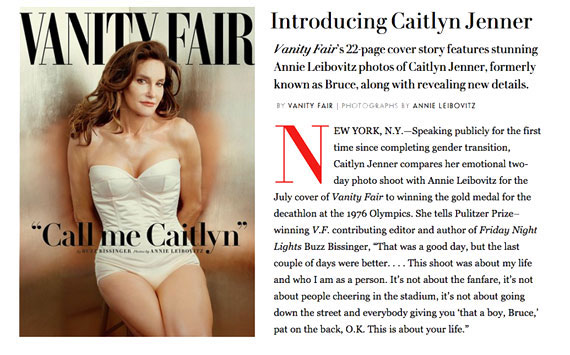
Caitlyn Jenner, a famed Olympic athlete and reality television star, completed her transition on June 1 and revealed it with a cover shoot in Vanity Fair. Wikipedia responded to this news in less than 30 minutes. Photo by Annie Leibovitz for Vanity Fair, used under fair use in the Wikipedia article discussing this photo.
Caitlyn Jenner—the American hero of the 1976 Olympics, a film actor, and prominent member of Keeping Up with the Kardashians—may now be the most famous openly transgender person in the world. She began her transition from Bruce in April; on June 1, she premiered her new name in Vanity Fair with a 22-page article and cover shot by famed photographer Annie Leibovitz.
As befitting someone with Caitlyn’s fame, the news has quickly gone viral around the Internet. There has, however, been conflict over how to address her. National Review Online asked “who won Bruce Jenner’s OIympic medals?” and questioned how individuals should write about a new gender identity set against Jenner’s extensive history in a gendered sport.”
By comparison, there has been little conflict on the English Wikipedia over Caitlyn Jenner. The first update was made just 21 minutes after Vanity Fair ’s tweet, and the page was moved after just over an hour. In part, this is thanks to more concrete guidelines after US Army soldier Chelsea Manning announced her own transition in August 2013. In that case, a Wikipedia administrator quickly moved the article to her new name. While this action received many accolades in the press—such as from Slate, Buzzfeed, the Daily Dot, and Market Watch—after a series of moves between the two names, the article was returned to its original title nine days later. It took more than a month to move it to the name Chelsea desired, time taken up with an extensive vote that saw 226 editors make over 2,000 edits, and an arbitration case before Wikipedia’s highest adjudicating body,
During and after this conflicted period, Wikipedia editors hammered out guidelines for how to deal with future cases. After thousands of bytes of text, a subsection of Wikipedia’s Manual of Style called “Identity” was edited to read, as of 1 June 2015:
“An exception … is made for terms relating to gender identity. In such cases, Wikipedia favors self-designation, even when usage by reliable sources indicates otherwise. Any person whose gender might be questioned should be referred to by the pronouns, possessive adjectives, and gendered nouns (for example “man/woman”, “waiter/waitress”, “chairman/chairwoman”) that reflect that person’s latest expressed gender self-identification. This applies in references to any phase of that person’s life, unless the subject has indicated a preference otherwise.”
This new guideline was applied to Caitlyn Jenner’s article and, in part, is the reason that her Wikipedia article has seen a comparative lack of controversy. The page was moved during a short, uncontentious discussion, and a subsequent move request was quickly close with a unanimous consensus to keep the article under its new name (Editor’s note: The author of this blog post, in his separate and volunteer role of administrator on the English Wikipedia, assessed the consensus and closed the requested move.) The article even uses Leibovitz’s Vanity Fair cover under the US’ fair use doctrine, quoting the Washington Post‘s interpretation of it: “After all the magazine covers that featured the former athlete … [this] photograph will be the most meaningful. Looking directly at the camera, Jenner is finally herself for the first time publicly.”
Those opposed to the move cited Wikipedia’s common name policy, a commonly cited page which stipulates that an article title be the name most used in reliable sources on the topic. This is why the article on Bill Clinton is not “William Jefferson Clinton,” for example.
Those in favor refuted these arguments with the identity guideline. One editor with the concluding comment in the main discussion section (as of the time of writing) wrote:
“I’m just going to say that if someone out there has access to wikipedia (aka: has internet), they clearly are not living under a rock. Even with mainstream media only covering her name change as of today, without living under a rock, there’s just no way the common public at large doesn’t already know that Bruce Jenner is now Caitlyn Jenner. So long as there’s a Bruce Jenner re-direct linking to this Caitlyn Jenner article (which there is), I really don’t understand why this conversation is even being had?”
The new title of Jenner’s Wikipedia biography, and the way Wikipedia has handled the situation, has garnered positive press attention from the Boston Globe, Washington Post, Bustle, Yahoo! UK, Zeleb, and Vocativ. Reactions on Twitter from users like Geeta Dayal and Hiro were also broadly supportive. Discussion is, however, continuing on whether links to Caitlyn’s biography should be from Bruce or Caitlyn.
A litany of frequently asked questions, and how the English Wikipedia deals with gender identity, have been laid out in a gender identity essay.
Ed Erhart
Editorial Intern
Wikimedia Foundation

Can you help us translate this article?
In order for this article to reach as many people as possible we would like your help. Can you translate this article to get the message out?
Start translation